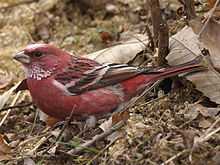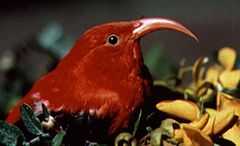Finch
| Finch | |
|---|---|
 | |
| Adult male common chaffinch (Fringilla coelebs) of the Fringillinae. | |
| Scientific classification | |
| Kingdom: | Animalia |
| Phylum: | Chordata |
| Class: | Aves |
| Order: | Passeriformes |
| Superfamily: | Passeroidea |
| Family: | Fringillidae Vigors, 1825 |
| Subfamilies | |
|
Carduelinae | |
The true finches are passerine birds in the family Fringillidae. They are predominantly seed-eating songbirds. Most are native to the Northern Hemisphere, but one subfamily is endemic to the Neotropics, one to the Hawaiian Islands, and one subfamily – monotypic at genus level – is found only in the Palaearctic. The scientific name Fringillidae comes from the Latin word fringilla for the common chaffinch (Fringilla coelebs) – a member of that last subfamily – which is common in Europe.
Many birds in other families are also commonly called "finches", including some species in the very similar-looking waxbills or estrildid finches (family Estrildidae) of the Old World tropics and Australia; several groups of the bunting and American sparrow family (Emberizidae); and the Darwin's finches of the Galapagos islands, now considered members of the tanager family (Thraupidae).[1]
Description

The smallest "classical" true finches are the Andean siskin (Carduelis spinescens) at as little as 9.5 cm (3.8 in) and the lesser goldfinch (C. psaltria) at as little as 8 g (0.28 oz). The largest species is probably the collared grosbeak (Mycerobas affinis) at up to 24 cm (9.4 in) and 83 g (2.9 oz), although larger lengths, to 25.5 cm (10.0 in) in the pine grosbeak (Pinicola enucleator), and weights, to 86.1 g (3.04 oz) in the evening grosbeak (Coccothraustes vespertinus), have been recorded in species which are slightly smaller on average.[2][3] They typically have strong, stubby beaks, which in some species can be quite large; however, Hawaiian honeycreepers are famous for the wide range of bill shapes and sizes brought about by adaptive radiation. All true finches have 12 remiges and 9 primary rectrices. The basic plumage colour is brownish, sometimes greenish; many have considerable amounts of black, while white plumage is generally absent except as wing-bars or other signalling marks. Bright yellow and red carotenoid pigments are commonplace in this family, and thus blue structural colours are rather rare, as the yellow pigments turn the blue color into green. Many, but by no means all true finches have strong sexual dichromatism, the females typically lacking the bright carotenoid markings of males.[1]
Finches are typically inhabitants of well-wooded areas, but some can be found on mountains or even in deserts. They are primarily granivorous, but euphoniines include considerable amounts of arthropods and berries in their diet, and Hawaiian honeycreepers evolved to utilize a wide range of food sources, including nectar. The diet of Fringillidae nestlings includes a varying amount of small arthropods. True finches have a bouncing flight like most small passerines, alternating bouts of flapping with gliding on closed wings. Most sing well and several are commonly seen cagebirds; foremost among these is the domesticated canary (Serinus canaria domestica). The nests are basket-shaped and usually built in trees, more rarely in bushes, between rocks or on similar substrate.[1]
Systematics and taxonomy
The taxonomic structure of the true finch family, Fringillidae, has been fairly disputed in the past, with some upranking the Hawaiian honeycreepers (Drepanidinae) as family Drepanididae and/or uniting the cardueline and fringilline finches as tribes (Carduelini and Fringillini) in one subfamily; the euphonious finches (Euphoniinae) were thought to be tanagers due to general similarity in appearance and mode of life until their real affinities were realized. In particular, North American authors have often merged the buntings and American sparrow family (Emberizidae) – and sometimes the bulk of the nine-primaried oscines – with the split-up Fringillidae as subfamilies of a single massive family. But the current understanding of Passeroidea phylogeny is better reflected in keeping the fundamental nine-primaried oscine clades as distinct families. However, Przewalski's "rosefinch" (Urocynchramus pylzowi) is now classified as a distinct family, monotypic as to genus and species, and with no particularly close relatives among the Passeroidea.[4]
Fossil remains of true finches are rare, and those that are known can mostly be assigned to extant genera at least. Like the other Passeroidea families, the true finches seem to be of roughly Middle Miocene origin, around 20-10 million years ago (Ma). An unidentifable finch fossil from the Messinian age, around 12 to 7.3 million years ago (Ma) during the Late Miocene subepoch, has been found at Polgárdi in Hungary.[5][6][7]
-
.jpg)
Cassin's finch (Haemorhous cassinii), an American rosefinch
-

Pallas' rosefinch (Carpodacus roseus), a true rosefinch
-
.jpg)
Hooded siskin (Spinus magellanica)
-

ʻIʻiwi (Vestiaria coccinea), a Hawaiian honeycreeper
-

Male Violaceous euphonia (Euphonia violacea)
-

European goldfinch, Carduelis carduelis
-

European greenfinch, Chloris chloris
Subfamilies and genera
The systematics of the cardueline finches are contentious. The layout presented here follows the recent decades' molecular phylogenetic studies, and takes into account the traditional splitting of the genus Carduelis. The exact position of several genera in the cardueline sequence is tentative.[8]
- Subfamily Fringillinae – fringilline finches. Three species, which feed their young on insects and few if any seed
- Genus Fringilla
- Subfamily Carduelinae – cardueline finches. A much larger group that contains several genera which feed their young mainly on seeds. This subfamily consists of several well-defined clades.
- Typical grosbeaks
- Genus Eophona – Oriental grosbeaks
- Genus Coccothraustes – Holarctic grosbeaks (polyphyletic?)
- Genus Mycerobas – Mycerobas grosbeaks
- Bullfinches
- Arid-zone clade
- Genus Leucosticte – mountain finches
- Genus N.N. – dark-breasted rosefinch, "Carpodacus" nipalensis
- Genus Rhodopechys – crimson-winged finch
- Genus Bucanetes – trumpeter finch and Mongolian finch
- Asian rosefinches
- Genus Carpodacus – rosefinches (Genus in need of substantial revision. May consist of two or more genera; alternatively may include Haematospiza and Uragus)
- Genus Haematospiza – scarlet finch
- Genus Uragus – long-tailed rosefinch
- American rosefinches
- Genus Haemorhous
- Goldfinch-canary-crossbill clade (Carduelis and Serinus are polyphyletic and are probably best regarded as a collection of independent sub-groups or genera.)
- Genus Serinus sensu lato – canaries, African seedeaters, serins and African siskins
- (Sub)Genus Serinus sensu stricto – European serin and relatives (possibly related to Spinus)
- (Sub)Genus Crithagra – Afrotropical canaries, African seedeaters, citrils (probably only distantly related to Serinus)
- Genus Linurgus – oriole finch (possibly basal to Crithagra)
- Genus Rhynchostruthus – golden-winged grosbeak (tentatively placed here)
- Genus "Serinus" thibetanus – Tibetan serin (probably related to Spinus and Serinus sensu stricto)
- Genus Carduelis – European goldfinch, citril finch and Corsican finch/ linnets, twite probably related to Spinus
- Genus Chloris – greenfinches
- Genus Rhodospiza – desert finch
- Genus Acanthis – redpolls
- Genus Loxia – crossbills
- Genus Spinus – siskins and American goldfinches
- Genus Serinus sensu lato – canaries, African seedeaters, serins and African siskins
- Carduelinae incertae sedis
- Genus Pyrrhoplectes – gold-naped finch
- Genus Chaunoproctus – Bonin grosbeak (extinct: 1830s)
- Genus Callacanthis – spectacled finch
- Genus Neospiza – Sao Tomé grosbeak
- Typical grosbeaks
- Subfamily Drepanidinae – Hawaiian honeycreepers. Endemic to the Hawaiian Islands; formerly often treated as a separate family.
- Some 10-12 living genera, about 7 recently extinct
- Subfamily Euphoniinae – Euphonious finches. Endemic to the Neotropics; formerly placed in Thraupidae.
- Genus Euphonia – euphonias
- Genus Chlorophonia – chlorophonias
See also
Footnotes
- ↑ 1.0 1.1 1.2 Newton (1973), Clement et al. (1993)
- ↑ Finches and Sparrows by Peter Clement. Princeton University Press (1999). ISBN 978-0691048789.
- ↑ CRC Handbook of Avian Body Masses by John B. Dunning Jr. (Editor). CRC Press (1992), ISBN 978-0-8493-4258-5.
- ↑ Clement et al. (1993), Groth (2000), Jønsson & Fjeldså (2006), Arnaiz-Villena et al. (2007)
- ↑ Hír et al. (2001), Mlíkovský (2002)
- ↑ Zamora, Jorge; Lowy, E.; Ruiz-del-Valle, V.; Moscoso, J.; Serrano-Vela, J. I.; Rivero-de-Aguilar, J.; Arnaiz-Villena, A. (2006). "Rhodopechys obsoleta (desert finch): a pale ancestor of greenfinches according to molecular phylogeny". J Ornithol 147: 448–56. doi:10.1007/s10336-005-0036-2.
- ↑ Arnaiz-Villena, A.; Gómez-Prieto, P.; Ruiz-de-Valle, V. (2009). "Phylogeography of finches and sparrows". Nova Science Publishers. ISBN 978-1-60741-844-3.
- ↑ Marten & Johnson (1986), Arnaiz-Villena et al. (1998, 2001, 2007, 2008)
References
- Arnaiz-Villena, A.; Álvarez-Tejado, M.; Ruiz-del-Valle, V.; García-de-la-Torre, C.; Varela, P.; Recio, M. J.; Ferre, S.; Martínez-Laso, J. (1998). "Phylogeny and rapid Northern and Southern Hemisphere speciation of goldfinches during the Miocene and Pliocene Epochs" (PDF). Cellular and Molecular Life Sciences 54 (9): 1031–1041. doi:10.1007/s000180050230. PMID 9791543.. Erratum: "Announcement/Addendum/Erratum". Cellular and Molecular Life Sciences (CMLS) 55: 148. 1999. doi:10.1007/s000180050280.
- Arnaiz-Villena, A.; Guillén, J.; Ruiz-del-Valle, V.; Lowy, E.; Zamora, J.; Varela, P.; Stefani, D.; Allende, L.M. (2001). "Phylogeography of crossbills, bullfinches, grosbeaks, and rosefinches" (PDF). Cellular and Molecular Life Sciences 58 (8): 1159–66. doi:10.1007/PL00000930. PMID 11529508.
- Arnaiz-Villena, A.; Moscoso, J.; Ruiz-del-Valle, V.; Gonzalez, J.; Reguera, R.; Wink, M.; Serrano-Vela, J.I. (2007). "Bayesian phylogeny of Fringillinae birds: status of the singular African oriole finch Linurgus olivaceus and evolution and heterogeneity of the genus Carpodacus" (PDF). Acta Zoologica Sinica 53 (5): 826–834.
- Arnaiz-Villena, A.; Moscoso, J.; Ruiz-del-Valle, V.; Gonzalez, J.; Reguera, R.; Ferri, A.; Wink, M. & Serrano-Vela, J.I. (2008). "Mitochondrial DNA Phylogenetic Definition of a Group of 'Arid-Zone' Carduelini Finches" (PDF). Open Ornithology Journal 1: 1–7. doi:10.2174/1874453200801010001.
- Clement, Peter; Harris, Alan & Davis, John (1993): Finches and Sparrows: an identification guide. Christopher Helm, London. ISBN 0-7136-8017-2
- Groth, J. (2000). "Molecular evidence for the systematic position of Urocynchramus pylzowi". Auk 117 (3): 787–792. doi:10.1642/0004-8038(2000)117[0787:MEFTSP]2.0.CO;2. JSTOR 4089604.
- Hír, János; Kókay, József; Venczel, Márton; Gál, Erika & Kessler, Eugén (2001). "Elõzetes beszámoló a felsõtárkányi "Güdör-kert" n. õslénytani lelõhelykomplex újravizsgálatáról [A preliminary report on the revised investigation of the paleontological locality-complex "Güdör-kert" at Felsõtárkány, Northern Hungary)]". Folia Historico Naturalia Musei Matraensis (in Hungarian with English abstract) 25: 41–64.
- Jønsson, Knud A.; Fjeldså, Jon (2006). "A phylogenetic supertree of oscine passerine birds (Aves: Passeri)". Zool. Scripta 35 (2): 149–186. doi:10.1111/j.1463-6409.2006.00221.x.
- Marten, Jill A.; Johnson, Ned K. (1986). "Genetic relationships of North American cardueline finches" (PDF). Condor 88 (4): 409–420. doi:10.2307/1368266.
- Mlíkovský, Jirí (2002): Cenozoic Birds of the World (Part 1: Europe). Ninox Press, Prague.
- Newton, Ian (1973): Finches (New Naturalist series). Taplinger Publishing. ISBN 0-8008-2720-1
Further reading
- Groth, J. G. 1994. A mitochondrial cytochrome b phylogeny of cardueline finches. Journal für Ornithologie, 135: 31.
- Groth, J. G. 1998. Molecular phylogeny of the cardueline finches and Hawaiian honeycreepers. Ostrich, 69: 401.
- Klicka, J., K.P. Johnson, and S.M. Lanyon. 2000. New World nine-primaried oscine relationships: Constructing a mitochondrial DNA framework. Auk 117:321-336.
- Ryan, P.G., Wright, D., Oatley, G., Wakeling, J., Cohen, C., Nowell, T.L., Bowie, R.C.K., Ward, V. & Crowe, T.M. 2004. Systematics of Serinus canaries and the status of Cape and Yellow-crowned Canaries inferred from mtDNA and morphology. Ostrich 75:288-294.
- Treplin, S. 2006. Inference of phylogenetic relationships in passerine birds (Aves: Passeriformes) using new molecular markers. (Dissertation - available online) http://opus.kobv.de/ubp/volltexte/2006/1123/pdf/treplin_diss.pdf.
- Yuri, T., and D. P. Mindell. 2002. Molecular phylogenetic analysis of Fringillidae, "New World nine-primaried oscines" (Aves: Passeriformes). Mol. Phylogen. Evol. 23:229-243.
External links
| Wikimedia Commons has media related to Fringillidae. |
| Wikisource has the text of The New Student's Reference Work article Finch. |
- Finch videos, photos and sounds on the Internet Bird Collection
- National Finch and Softbill Society A organization promoting breeding
.jpg)